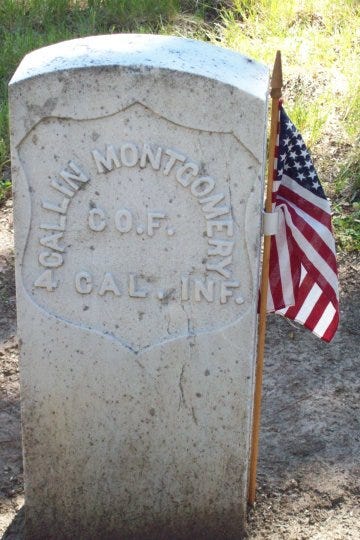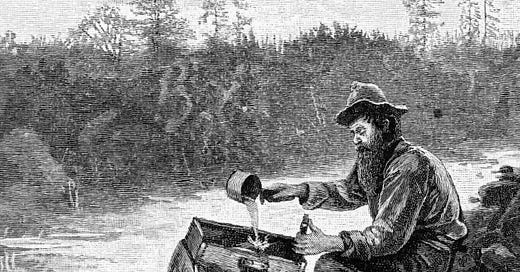Once upon a time, several families founded a town in Ohio.
Benjamin Montgomery (1766-1841) brought his wife, Nancy, and their six children from Virginia to settle in Weller Township, Richland County, Ohio, where they laid out a town in 1816. Benjamin called the town “Olivesburg” after his daughter, Olive, who was then 21 years old. Surviving accounts say that Olive had received a polished education in Virginia, and she naturally fell into the task of teaching the children of new settlers. In 1833, Benjamin and Nancy filed a deed to give land to the village of Olivesburg for a schoolhouse, cemetery, and a lot for a church.
Members of the Montgomery family were industrious, and Benjamin’s sons were attached to several local businesses. According to A. A. Graham’s History of Richland County (pg. 623), Abel (his eldest son, born in 1792) kept the blacksmith shop, Jonathan (his youngest, born 1801), and Benjamin ran the tavern. Abel’s name also appears on the list of founding members of the Hopewell Presbyterian Church, along with the name of Mary Callin.
The Callin family farm lay a few miles west of Olivesburg. Two brothers, Mary’s husband, James, and John Callin had come from western Pennsylvania in 1810 and 1816, respectively. The details are lost to history, but according to the 1911 Callin Family History, James Callin “was killed in an altercation with a man named Fowler who struck him over the head with a rifle” in 1820.1 While this left Mary widowed and caring for their six children, she was not alone. Her brother-in-law and his wife, Elizabeth, had nine children, and between the two families, eight of those children were teenagers capable of maintaining a farm.
During the decade after James Callin was killed, his children came of age and married. Three of James and Mary’s four oldest children married children of Benjamin and Nancy Montgomery:
Elizabeth Callin (1798–1834) m. Caleb Montgomery (1799-1872) on 13 Aug 1822
Thomas Callin (1801–1843) m. Nancy (Ann) Burgett (1804–1871) on 20 Nov 1823
Hugh Callin (b. 1803) m. Lucinda Montgomery (b. 1810) about 1825
Sarah Callin (1807–1830) m. Jonathan Montgomery (1801-1898) in 1824
All of them had children with interesting stories, but for today, we’re just going to trace the trajectory of one of these families.
Elizabeth and Caleb Montgomery
Between their wedding in 1822 and her death in 1834, Elizabeth gave Caleb five children. Her sister, Sarah, who had married Caleb’s brother, Jonathan, had also died young in 1830, leaving three young daughters. There is no evidence to say why they died, though disease is the most likely culprit. I suspect they may have had tuberculosis. Their uncle, John Callin, died of the disease in 1835, and since they grew up on the same farm, they could have been exposed.
Caleb soon remarried and he and his second wife, Sarah Mercer (1812-1877) had a son, Levi (1835), and a daughter, Elizabeth (1836) in Ohio before Caleb decided to move his family to Fulton County, Indiana, in 1838. Once settled in their new home in Newcastle Township, they had eight more children between 1838 and 1851.
The first child of Elizabeth and Caleb was Mary Montgomery, born in 1823. She married James Ferrell in Rochester, Fulton County, Indiana, on 23 Mar 1843. He may have been one of the Ferrell family from Milton Township, but we know nothing about him outside of his marriage to Mary. They had a daughter, Sarah Elizabeth Ferrell (1846-1916) in January 1846. We know that Mary died in April 1846 and that little Sarah was taken in and raised by Mary’s sister, but we do not know what happened to James Ferrell.
Mary’s sister was named Sarah Montgomery. She was born in Milton Township on 27 December 1824 and married Henry Davidson (1818–1894) in Fulton County on 22 Apr 1841. They would take their family—including their adopted niece, Sarah Ferrell—on the Oregon Trail in 1853, but we will have to talk about that adventure another time.
Theodore Montgomery was the third child and oldest of three sons born to Elizabeth and Caleb in 1826. At 20, he enlisted in Indiana’s First Regiment and served one year in the Mexican War of 1847. He married Margaret Wilson (1831-1916) in 1849, and they embarked on a two-year adventure to try their hand at gold mining in California. Unlike most of those who made the trip, Theodore returned to Rochester with $5,000 (about $203,635.26 today) and bought a farm. He and Margaret raised four sons and a daughter there.
The two youngest sons were Porter and Callin “Cal” Montgomery. Porter Montgomery was born about 1828, and is said to have died “at Vicksburg, Miss.”—though there aren’t any records that tell us when he died or whether he was killed in the Civil War. Callin Montgomery was born in 1830, so he would have been about eight years old when his father moved the family to Indiana.
Their father, Caleb, died in Newcastle Township on 23 Feb 1872.
Callin Montgomery: the Old Prospector
We do not know much about Cal's early life. Cal was not named in the secondary sources as a member of his brother's group when Theodore traveled to the gold country around 1849, but Cal would have been 20 at the time. Since there is no 20-year-old Callin Montgomery listed in Rochester on the 1850 Census, it seems likely that he either accompanied his brother's party or set out on his own soon after.
The earliest record we have for Cal is a "C Montgomery" listed in Coloma, El Dorado County, California, on the 1860 Census. If he did follow the Gold Rush with his brother, he may not have been successful—or he may have decided that success did not include buying an Indiana farm.
Military records suggest that Cal enlisted in the Union Army, serving in Company F of the 4th Regiment, California Infantry on 16 October 1861. He was stationed at Benicia Barracks in 1863, and he mustered out on 26 August 1864 at Drum Barracks.
After the war, he returned to Coloma, appearing in the 1870 Census as a saloon keeper with a wife, Laura S, age 18. 1870 is the only time we see Cal married. Laura, who was recorded as being "3/4 white" and born in California, does not appear in any other records. By 1880, Cal was listed as single again, living in Gold Hill, El Dorado County, and working as a placer miner.
Numerous voter registration records and occasional mentions in The Record-Union of Sacramento over the years establish Cal as the kind of colorful side character you might see in an old western. He was the ol' prospector who passed word of a generous stranger in Coloma to a Wells Fargo official in Placerville, thus helping authorities solve a stagecoach robbery. He was the grubby old timer who dealt with the remains of a Chinese man who was suffering from leprosy and committed suicide, leaving a corpse no one wanted to go near hanging in a remote cabin. (Fair warning: that story was written to sell papers, not to pay respects to the dead.)
Cal lived in El Dorado county until he was in his eighties, appearing on the 1910 census at a Pilot Hill address in Greenwood. The California, Death Index, 1905-1939 records his death on 3 October 1912 in Napa County, California. When he died, someone had him buried in Veterans Memorial Grove Cemetery in Yountville, Napa County.

The 1820 U.S. Census shows “Sutton Fowler” listed just below “James Calan”—also below Fowler, there are Thomas and Boston Burget, candidates for Nancy Burgett’s family.






Great research. Have you considered undertaking a one-place study focused on Milton township?
I am always impressed with the quality of the research in these posts.